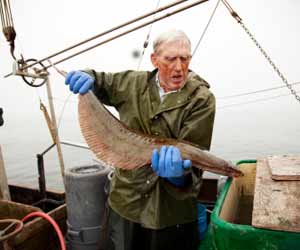Deckhand Opportunities on Halibut Longliners
About 4,000 halibut boats currently fish in Alaska waters. The primary ports include Petersburg, Kodiak, Sand Point, Wrangell, Pelican, and Sitka. Traditional halibut boats require a crew of between 4-8, so quite a few halibut jobs exist. The still-dominant, traditional longlining method involves setting out 10 miles of groundlines, from which up to 15,000 six-foot, hooked, and octopus-baited lines called “gangions” branch out at regular intervals. Upon locating a suitable sandy-bottomed area (usually around 500-600 feet deep), one end of the groundline is played out, anchored, and marked with a buoy and flag. The rest of the line and the gangions are slowly played out. Then the second end of the groundline is anchored and marked. The same process is repeated with several lines.

The halibut are harvested by hauling in one end of the line with a winch called a “girdie.” Meanwhile, one of the crew removes the fish, another carefully recoils the lines, and the rest clean, ice, and store the haul. The gangions are re-baited, the lines reset, and the process is repeated with the next line. During the old derby openings, crews would repeat this process as quickly as possible for up to 48 straight hours.
Although the traditional method is still used most often by halibut fishermen, many have begun to automate their boats. Automated longlining is less labor-intensive because many of the steps normally undertaken by the crew – baiting, setting, hauling, bait-removal, and untangling – are either done automatically or are machine-assisted.
Becoming a Deckhand
The best way to get a deckhand job on a halibut boat is to walk the docks and get to know some skippers and other people who work the halibut season or to contact halibut IFQ holders or boat owners in your area (for a complete list, go to AlaskaJobFinder.com). “Inbreakers” are usually offered half of a regular crew share on their first trip out. After that, the crew votes whether or not to offer a promotion to a full share. With the new IFQ system there is only one season per year and it will be hard to predict just when during the season a captain will decide to go after his quota. Since many skippers won’t start fishing until well after the season opening, dock stomping before the opening in March won’t be very effective. This makes it even more important that you keep your ears open and talk to as many halibut fishermen as you can.
Try to find out a bit about the skipper and the experience of the crew before accepting a job. Take precautions, because halibut gear is highly specialized and can be dangerous. Make sure there are operating survival suits for everyone aboard.
Deckhands and other crew members are paid on a share system, so compensation depends on the quality and market value of the fish and the number of people sharing the proceeds. Regular crew are paid equal shares of the boat’s earnings after expenses and the owner’s share (usually 30 to 40 percent) are deducted. Inbreakers normally get half of a crew share their first time out. After that, the crew votes to decide whether to offer a full share. Since the price of halibut has been historically very high for the last few years, crew members usually make $6,000 to $10,000+ per month of fishing.
Processing Halibut
Halibut are processed in a manner similar to groundfish.

